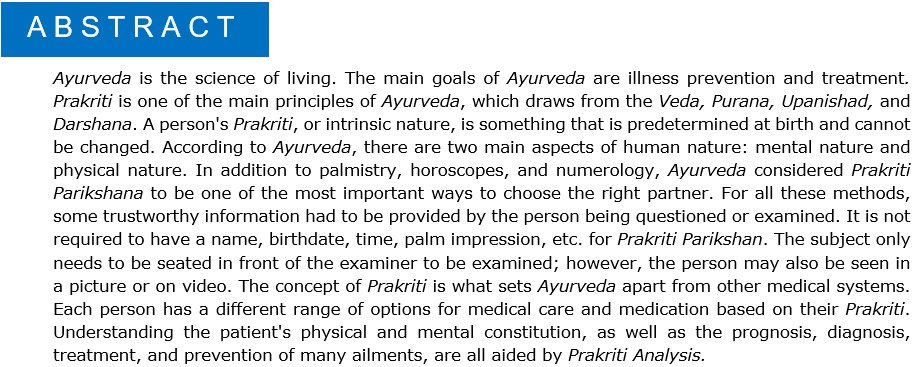Brief knowledge of Prakriti and its importance
DOI:
https://doi.org/10.21760/jaims.9.1.30Keywords:
Ayurveda, Prakriti, Prakriti Parikshana, Physical and Mental ConstitutionAbstract
Ayurveda is the science of living. The main goals of Ayurveda are illness prevention and treatment. Prakriti is one of the main principles of Ayurveda, which draws from the Veda, Purana, Upanishad, and Darshana. A person's Prakriti, or intrinsic nature, is something that is predetermined at birth and cannot be changed. According to Ayurveda, there are two main aspects of human nature: mental nature and physical nature. In addition to palmistry, horoscopes, and numerology, Ayurveda considered Prakriti Parikshana to be one of the most important ways to choose the right partner. For all these methods, some trustworthy information had to be provided by the person being questioned or examined. It is not required to have a name, birthdate, time, palm impression, etc. for Prakriti Parikshan. The subject only needs to be seated in front of the examiner to be examined; however, the person may also be seen in a picture or on video. The concept of Prakriti is what sets Ayurveda apart from other medical systems. Each person has a different range of options for medical care and medication based on their Prakriti. Understanding the patient's physical and mental constitution, as well as the prognosis, diagnosis, treatment, and prevention of many ailments, are all aided by Prakriti Analysis.
Downloads
References
Maharsi Agnivesh. Charaka Samhita. 4th ed. Varanasi: Chowkhamba Krishnadas Academy; 2017. Vimana Sthana 8/95. p. 918. Edited and commented by Late Dr. Lakshmidhar Dwivedi, Dr. B.K. Dwivedi, and Dr.P.K. Goswami.
Maharsi Agnivesha. Charaka Samhita. 4th ed. Varanasi: Chowkhamba Krishnadas Academy; 2017. Vimana Sthana 8/95. p. 918. Edited and annotated by Late Dr. Lakshmidhar Dwivedi, Dr. B.K. Dwivedi, and Dr.P.K. Goswami.
Tripathi B. Nirmala. In: Srimadvagbhata Astanga Hrdayam. Delhi: Chaukhamba Sanskrit Pratishthan; 2019. Reprint. Sharir Sthana 3/83. p. 381.
Sushruta. Sushruta Samhita with Nimandhasamgraha Commentary on Dalhan. Varanasi: Chaukhambha Orientalia; Sharirasthana, 2019. Edited by Trivikram Yadavji.
Acharya Agnivesha. Charaka Samhita. Vol. II. Varanasi: Chaukhamba Academy; Vimana Sthana chap. 8. Edited by Dr. Laxmidher Diwvedi.
Acharya Agnivesa. Charaka Samhita. Edited by Brahmanda Tripathi. Vimana Sthana 8/100.
Astanga Hrdayam. 9th ed. Varanasi: Chaukhambha Academy; 2019. Edited by Vaidya Hari Shastri Paradakar. Includes commentary of Arundatta and Hemadari.
Sushruta. Sushruta Samhita with Nimandhasamgraha Commentary on Dalhan. Varanasi: Chaukhambha Orientalia; Sharirasthana, 2019. Edited by Trivikram Yadavji. Chap. 4 verse 62.
Sharma P, Sodhi D, Gupta V, Dadhich N. A Retrospect on Prakriti and Lifestyle. Int J Ayu Pharm Chem. 2015;2(3).
Maharsi Agnivesh. Charaka Samhita. 4th ed. Varanasi: Chowkhamba Krishnadas Academy; 2017. Vimana Sthan, 8/95. p. 918. Edited and discussed by Late Dr. Lakshmidhar Dwivedi, Dr. B.K. Dwivedi, and Dr. P.K. Goswami.
Srimadvagbhata Astanga Hrdayam. Delhi: Chaukhamba Sanskrit Pratishthan; 2019. Reprint. Sharir Sthana 3/83. p. 381. Edited with Nirmala Hindi Commentary by Brahmanand Tripathi.
Maharsi Sushruta. Susruta Samhita. 2nd ed. Varanasi: Chaukhambha Sanskrit Sansthan; 2019. Sharir Sthana, 4/79. p. 51. Edited by Kaviraja Ambikadutta Shastri. Foreword by Dr. Pranajivana Manekchanda Mehata.
Sheldon WH. The Variants of the Human Body: An Introduction to Constitutional Psychology. New York: Harper; 1940.
Tripathi PK, Patwardhan K, Singh G. The Basic Cardiovascular Reactions to Postural Alterations, Exercise, and the Cold Pressure Test: Do They Differ in Accordance with the Dual Ayurvedic Constitution Types. Evid Based Complement Alternat Med. 2011;251850.
Tripathi BN, editor. Charaka and Agneeshkrit Analysis of the Charaka Samhita. Varanasi: Chaukhambha Prakashana; 2008. Sutra Sthana 1. p. 124.
Maharsi Agnivesha. Charaka Samhita. 4th ed. Varanasi: Chowkhamba Krishnadas Academy; 2017. Vimana Sthan 8/96-100. p. 918-921. Edited and discussed by Late Dr. Lakshmidhar Dwivedi, Dr. B.K. Dwivedi, and Dr. P.K. Goswami.
Dridhabala. Charaka Samhita. 7th ed. Varanasi: Agnivesha Chowkhamba Sanskrit Series Office; 2002. Sharira Sthana, Katidhapurushiya Shariradhyaya 1/102-109. Text by Dr. Ram Karan Sharma and Vaidya Bhagvan Dash with English Translation and Critical Exposition Based on Chakrapanidatta's "Ayurveda Dipika."
Maharsi Agnivesha. Charaka Samhita. 4th ed. Varanasi: Chowkhamba Krishnadas Academy; 2017. Vimana Sthan 6/12. p. 84. Edited and discussed by Late Dr. Lakshmidhar Dwivedi, Dr. B.K. Dwivedi, and Dr. P.K. Goswami.















